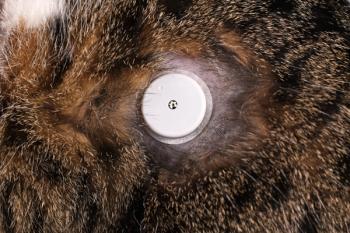
|Articles|October 1, 2011
Malfunctioning adrenals: how to diagnose them (Proceedings)
Author(s)Cynthia Ward, VMD, PhD, DACVIM
Hypothalamic-pituitary-adrenal (HPA) axis--classic endocrine feedback loop
Advertisement
Regulation of Secretion of glucocorticoids - corticosterone and cortisol
- Hypothalamic-pituitary-adrenal (HPA) axis - classic endocrine feedback loop
- CRH (hypothalamus)
- ACTH (pituitary)
- Cortisol (adrenals)
- Cortisol negative feedback on CRH and ACTH release
Diseases of the Adrenal Cortex and how to diagnose them
- Hypoadrenocorticism
- primary disease - destruction of the adrenal cortex
- iatrogenic
- mitotane (Lysodren)
- trilostane (Vetoryl) – can also cause adrenal necrosis
- abrupt withdrawal of glucocorticoids
- bilateral adrenalectomy
- Diagnosis
- Decreased Na:K ratio - less than 25-27 consistent with addison's disease
- ACTH-stimulation test – definitive test
- normal pre 1-4 mcg/dl cortisol
- normal post 10-18 mcg/dl cortisol
- Addisons: pre and post sample <1 mcg/dl of cortisol
- Low dose ACTH (5 mcg/kg cortrosyn) effective
- Resting cortisol levels
- 2 ug/dl or greater, probably not Addisons
- Hyperadrenocorticism
- Pathogenesis
- Primary disease
- adrenal tumor with overproduction of
- glucocorticoids
- approximately 15% of animals have this
- 50% carcinoma
- secrete cortisol as well as cortisol precursors
- usually unilateral; can be bilateral
- Secondary disease
- pituitary microadenomas that overproduce ACTH
- approximately 85% of animals have this
Advertisement
- pituitary-dependent hyperadrenocorticism (PDH)
- macroadenomas can cause neurologic signs
- iatrogenic - overuse of exogenous glucocorticoids
- PDH and adrenal tumors have been found in same animal
- Diagnostic screening tests – Cushing's yes/Cushing's no
- Urine cortisol:creatinine ratio
- Rationale: gives cortisol estimation since last time dog urinated - so usually get an estimate of plasma cortisol over several hours
- Procedure: collect urine sample (preferably owners collect at home); urine cortisol measured and compared to creatinine to normalize
- For urine concentration
- Interpretation - if morning urine (really should be 3 on separate days)
- sample(s) less than 10 (or use your lab's reference ranges) then animal probably doesn't have Cushing's. If > 10 then you need to do another screening test. Very sensitive; not specific
- ACTH-stimulation test
- Rationale: stimulate gland to determine hormonal reserve;
- If gland is hyperfunctioning you should get an exaggerated response interpretation:
- Normal pre 1-4 mcg/dl cortisol normal post 10-18 mcg/dl cortisol
- Gray area post sample (may/may not be hyperadrenocorticism)18-22 mcg/dl
- Post > 22 mcg/dl think hyperadrenocorticism
- Uses:
- Test of choice for diagnosing iatrogenic hyperadrenocorticism
- Screening test for hyperadrenocorticism – is a more specific test in animals with concurrent disease
- Monitoring lysodren therapy
- 60-75% sensitive
- 85-90% specific
- Low Dose Dexamethasone Suppression Test (LDDS)
- Rationale: take advantage of the normal negative feedback mechanism in the HPA axis. If you can't suppress the system normally, then suspect hyperadrenocorticism
- Procedure:
- Get baseline cortisol
- Give 0.01 mg/kg dexamethasone IV
- Get 4 and 8 hour post-injection cortisol samples
- Can use dexamethasone SP or dexamethasone in polyethylene glycol
3. Interpretation:
- Look at the 8 hour post-injection sample first; in a normal animal it should be below the normal range; the gray area in which you can't make a diagnosis is 1.0-1.4 ug/dl; greater than 1.4 mcg/dl is consistent with hyperadrenocorticism
- The 4 hr post-injection sample is used as a discriminating test (to tell whether there is an adrenal tumor or PDH)
4. Advantages:
- More sensitive for diagnosis of hyperadrenocorticism 85-95% sensitive
- By getting the four hour sample, can also use as a discriminating test for hyperadrenocorticism (i.e. tell whether hyperadrenocorticism is due to a pituitary or adrenal tumor)
5. Disadvantages:
- 8 hour test
- May be less specific in animals with concurrent disease (i.e. get false positives) 70-75% specific
6. Uses:
- Screening test for hyperadrenocorticism
- Discriminating test for hyperadrencorticism
- Discriminating Tests for Adrenal Function (tests to differentiate pituitary- versus adrenal-dependent hyperadrenocorticism)
- Low Dose Dexamethasone Suppression test – 4 hour sample
- Endogenous ACTH levels
- Measure on a single blood sample
- If how – adrenal tumor
- If very high – PDH
- Significant overlap between normal and dogs with PDH
- Ultrasound
- Look for adrenal tumors and contralateral adrenal atrophy
- Look for bilateral adrenal enlargement
- Look for potential metastatic disease
- High Dose Dexamethasone Test (HDDST)-no longer recommended
ACTH-Stimulation Test
- Synthetic ACTH (cortrosyn)
- ACTH gel – compounded by compounding pharmacy (be careful)
- Cortrosyn
- 5 mcg/kg cortrosyn IV (or IM)
- adrenal hormone(s) that you want to measure before and 45-60 min after injection
- Can reconstitute and freeze cortorsyn in aliquots. Stable for 6 months.
- ACTH gel – trust your pharmacy
- 2.2 U/kg IM or check with your pharmacy
- Adrenal hormone(s) measured pre and 2 hours post injection
- Feline Adrenal Axis Testing
- LDDST – use 0.1 mg/kg of dexamethasone (instead of 0.01 mg/kg of dex for a dog); use the same criteria for diagnosing hyperadrenocorticism
- ACTH-stimulation test
- ug/kg synthetic ACTH IV
- Cortisol levels at 60 and 90 minutes
- Cortisol above 16 ug/dl (slightly lower than dogs) consistent with hyperadrenocorticism
- Low sensitivity (~50%)
- Adrenal ultrasonography
Newsletter
From exam room tips to practice management insights, get trusted veterinary news delivered straight to your inbox—subscribe to dvm360.
Advertisement
Advertisement
Advertisement
Trending on dvm360
1
Proposed veterinary college receives approval from state's higher education board
2
Federal officials confirm Wisconsin’s first case of bird flu in a dairy cattle herd
3
Tailor lymphoma treatment to each patient
4
Q&A: Chief veterinary technician and motivations
5





